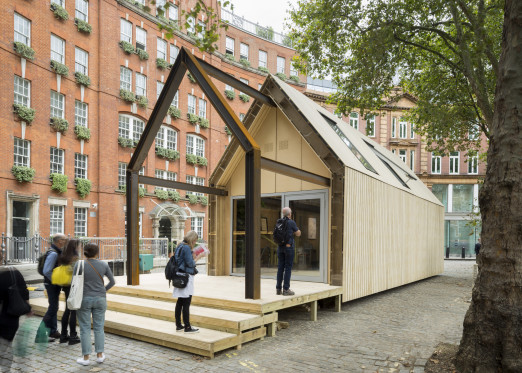Tested to withstand sun, rain and hurricane-force winds, the Hy-Fi brick tower designed by studio The Living won the 2015 MoMA Young Architects Program. Arup provided structural engineering services. The bricks are made from microscopic, fibrous fungi bound to agricultural waste. The mixture is grown in custom-shaped trays made from a pioneering 3M reflective daylighting film, which directs sunlight further into buildings. All of the materials used to construct Hy-Fi are sourced within a 150 miles radius of the structure and require zero energy to create.
Regenerate / Exchange
Bricks. The Living, Arup, Ecovative (Agricultural waste, mycelium, New York, NY, 2014)
Interview with the Ecovative CEO and Co-Founder Eben Bayer
Could you explain the context of your collaboration with New York design studio The Living?
Eben Bayer: Architect David Benjamin of New York firm The Living walked into our offices with a brick grown from fungi. This brick was the key to his concept for an entry to MoMA PS1’s Young Architects Program competition. Every year, the museum commissions a designer to build a centrepiece for its popular outdoor concert series.
If architectural design competitions are where brave, innovative ideas rise to the top, The Living’s mushroom tower (official name: Hy-Fi) checked all the right boxes. In addition to the novelty factor, mushroom bricks offer a host of sustainability benefits. The raw materials needed to produce them — mushrooms and corn stalks (waste material from farms) that the spores feed on — are as eco-friendly as they come. Bricks can be grown in just five days, and the process produces no waste or carbon emissions. When the structure is taken down at the end of the summer, they can be composted and turned into fertiliser.
What inspired the idea to use such bricks? How did you research their suitability?
(Hy-Fi Tower, mushroom bricks. The Living, Arup, Ecovative, 2014)
Eben Bayer: Design competition entries must walk a thin line between avant-garde thinking and real-world potential — just the sort of challenge that Arup engineers relish.
David’s inspiration sprung from Ecovative, a manufacturing company founded to develop practical, economical uses for the mushroom spore mycelium. A microscopic, fibrous fungus, mycelium binds itself to its food source to create a strong, resilient matrix in any shape desired: packaging for Dell computers, for example. Now Ecovative had grown a mushroom brick, and The Living wanted our help in figuring out how to use it.
In addition to the novelty factor, mushroom bricks offer a host of sustainability benefits. The raw materials needed to produce them – mushrooms and corn stalks (waste material from farms) that the spores feed on – are as eco-friendly as they come. Bricks can be grown in just five days, and the process produces no waste or carbon emissions. When the structure is taken down at the end of the summer, they can be composted and turned into fertiliser.
(Hy-Fi Tower, mushroom bricks. The Living, Arup, Ecovative, 2014)
Were there any unusual engineering issues you had to address in constructing a tower from these bricks?
Eben Bayer: In the initial phase, we didn’t have the luxury of a formal testing lab. The big call “Yes, it is possible” – came from standing on a brick, then calculating its strength based on the weight of a structural engineer.
Using the results of the standing-on-a-brick test, we calculated that a 40-foot-tall chimney would work as a base scheme. As the design evolved, one chimney eventually became three, and finally one tower woven out of three chimneys.
Testing was at the centre of the engineering design. The results would help us shape the bricks themselves, choose how to arrange them, and decide how to connect them. Most importantly, they would help us make sure the structure could withstand a storm.
No one person can solve so many interwoven problems at once. The success or failure of this kind of project rests on how well the collaborators work together to navigate unknowns, each contributing essential pieces of knowledge which eventually become greater than the sum of the parts.
In this case, the process worked incredibly well. Columbia University Laboratory provided scientific load tests. Melissa Burton at BMT Fluid Mechanics figured out what wind pressure the structure could see during the summer. Desmond Cook at Advanced Metal Coatings provided accelerated aging tests. Art Domantay Artworks helped us all think about how the tower would be built. Ecovative kept experimenting, producing different brick types with varying densities and strengths. Arup turned data into designs and provided confidence about their viability, all the while looking for opportunities and risks and providing guidance about what testing should be done next. Leading the team and tying everything together, The Living masterfully crafted a sculpture out of all this information, drawing every brick along the way.
This was an experimental project but what insights for future constructions based around circular economy strategies and actions did you discover?
Eben Bayer: Mushrooms might not replace steel and concrete soon, but Hy-Fi shows that they do have a place in today’s construction market. Ecovative is continuing to experiment with products for the built environment, and we at Arup look forward to working with them to push the material forward in the coming years.
_Arup4.jpg)
_Arup2.jpg?1473756994)
_Arup.jpg?1473757002)


_ICD_ITKE.jpg)

